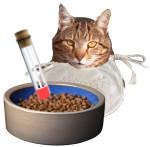Cultured meat as pet food

The concept of lab-grown meat has been around for a while - but recently such meat has gone from concept to plate. Indeed last December, Singapore gave regulatory approval for the world's first 'clean meat' - 100% meat that has never been inside an animal. In January 2020 the world's first lab-grown chicken nuggets were served in a Singapore restaurant.
Although most companies work on clean meat for human consumption, some pet food producers are also turning their attention to the product. So what is cultured meat, how do they make it, and will your cat notice any difference?
Well, cultured meat is produced from so-called stem cells. These cells can be obtained from a small sample taken from a live animal (which is still alive afterwards) and then multiplied in the laboratory. Given the right nutrients the extracted cells can then be grown indefinitely and converted into muscle cells - which provide the best meat. One of the biggest challenges in producing such meat for human consumption is not the taste (cultured meat really does taste the same as meat from slaughtered animals) but the look. Humans like to eat a juicy steak or nice chicken nugget - not mushed-up cells. But cats and dogs are not that bothered about presentation. As long as their food is tasty and nutritious the rest does not really matter to them. (As we can see from the appearance of some pet foods already on the market!) So production of clean meat for pets is now ramping up with companies like Because Animals, Bond pet foods and Wild Earth promising deliveries by the end of this year.
Because Animals grows cells in a way similar to how meat is cultured for human consumption, although to satisfy our cats the company is hoping to offer not only chicken and fish but also mouse meat for an 'all-natural' diet. Bond pet food, on the other hand, is going one step further. Instead of growing their cells directly, they extract the genes necessary for the production of chicken proteins and insert these into yeast cells. The advantage of yeast cells is that they can be grown much faster in vats similar to those used for production of beer. The resultant proteins are then extracted and used as a base for the pet food.
So why grow meat in the lab?
Well, there are many reasons including ethical, nutritional, and environmental and we will examine each in more detail below, starting with ethics..
As all cat owners know, cats are compulsory carnivores and that creates a dilemma for many pet owners including those who are not vegetarian or vegan. With cultured meat no animals are killed or even seriously harmed. Large tracts of land are not needed and therefore no wild animals get displaced due to the expansion of farmland for the needs of humans and their pets. So here ethical and environmental concerns go hand-in-hand.
With safety, cultured meat tastes exactly like meat obtained from farm animals but does not carry health risks such as contamination with harmful bacteria or viruses. No antibiotics are needed or ever used in culturing cells. As an additional benefit to culturing meat in a vat, the growers can introduce nutrients normally lacking in conventional meat, such as omega 3, into the culture medium and this is then taken up by the cells as they grow.
Finally, culturing meat also has greenhouse benefits. According to Dr Shannon Falconer, the co-founder and CEO of Because Animals, the production of 1 kg of cultured meat generates just 1.7 kg of CO2 emissions compared to 27 kg of CO2 emissions for the production of the same quantity of conventional beef. Farm animals also use far more water than cells grown in a vat.
For the moment the main drawback with cultured meat is the price. Once it comes on to the market we can expect that the first pet food will be somewhat pricey. But once the technology and the popularity of cultured meat becomes established the prices will go down.
References:
1. https://becauseanimals.com/pages/making-meat
2. https://wildearth.com/products/clean-protein-dog-food
3. https://podcasts.apple.com/us/podcast/cleaner-safer-more-responsible-pet-food/id1452858646?i=1000476899812
4. Try it on the dog (cell cultures as pet food). The Economist (2021) January 30th - February 5th Edition.
The information supplied here is intended as a guideline only.
